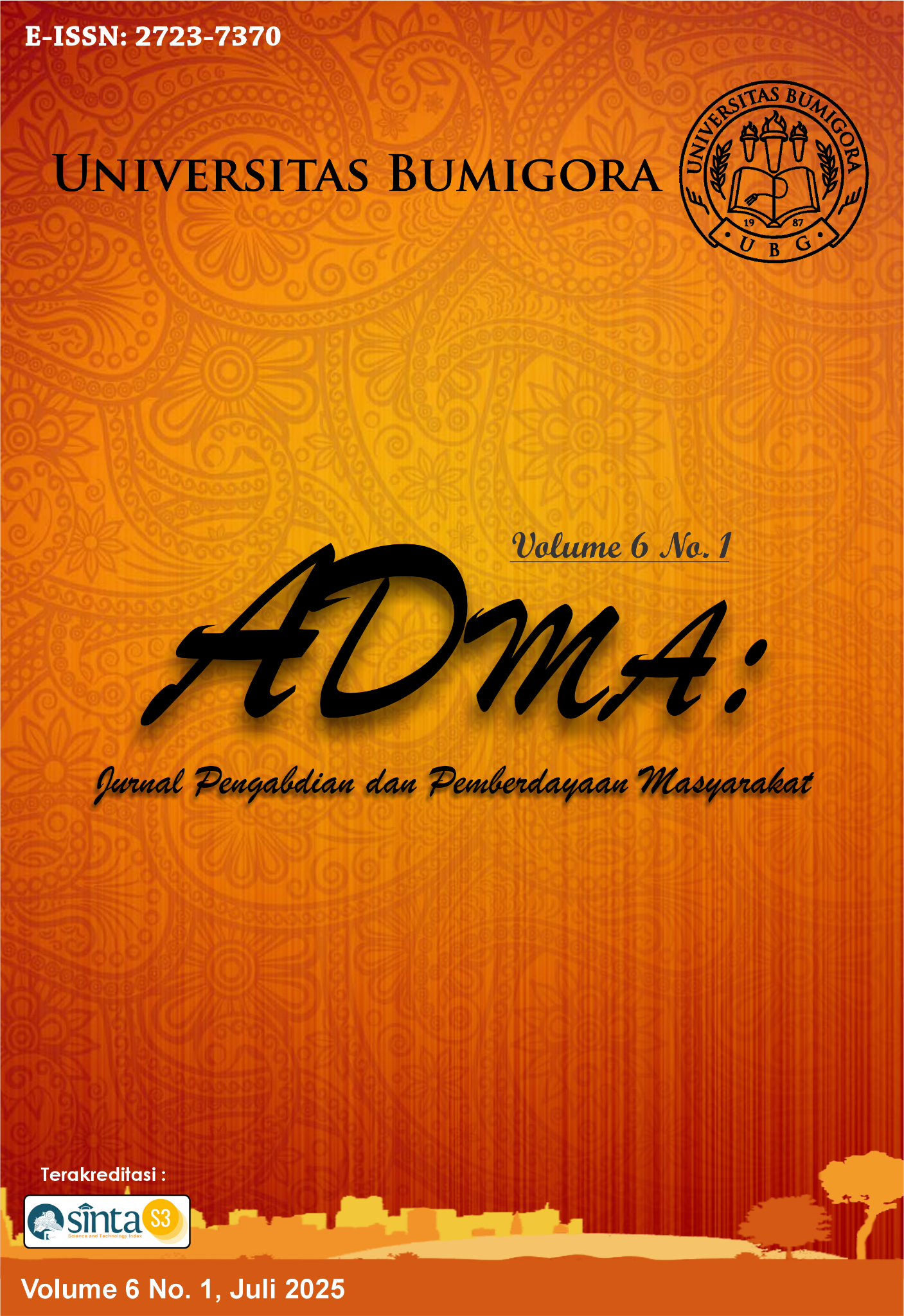Enhancing The Understanding of Villagers in Semoyo Patuk Gunungkidul Yogyakarta Regarding Medicinal Chemical in Commercial Natural Products
DOI:
https://doi.org/10.30812/adma.v6i1.5102Keywords:
community empowerment , medicinal chemical, natural product , side effectsAbstract
The consumption of herbal medicine in Indonesia has attracted people since ancient times. The trend of consuming jamu is increasing along with the COVID-19 pandemic. Some studies mention that medicinal chemical ingredients are added to marketed natural medicines for a specific purpose, that is not allowed. These medicinal chemicals are known to cause side effects that are very harmful to the body. This reported program aims to improve knowledge regarding the dangers of medicinal chemicals added in marketed natural products. The participants of this program were 30 members of Argomoyo Sejahtera inSemoyo Village, Patuk, Gunung Kidul, Yogyakarta. This program was held on Saturday, May 4th, 2024, at Universitas Muhammadiyah Yogyakarta (UMY). This program was carried out through education about medicinal chemicals added in marketed natural products. Participants were given a questionnaire before and after the education to evaluate their knowledge regarding the delivered materials. Data of the pre and post test were analysed using paired sample t-test. The results show that there is a significant increase in participants' knowledge, with a p-value of 0.017 (<0.05). These results indicate that education could effectively enhance knowledge about medicinal chemicals' dangers which are added to marketed natural products.
References
Anwar, K., Utami, M. N., Na, L., & Pertiwi, T. N. (2024). Edukasi Bahaya Bahan Kimia Obat (
BKO) dalam Obat Tradisional dan Pembuatan Jamu di Desa Sumberahayu. 6(1), 40–44.
https://doi.org/10.53359/dimas.v6i1.81
Campbell, N., Clark, J. P., Stecher, V. J., Thomas, J. W., Callanan, A. C., Donnelly, B. F.,
Goldstein, I., & Kaminetsky, J. C. (2013). Adulteration of purported herbal and natural
sexual performance enhancement dietary supplements with synthetic phosphodiesterase
type 5 inhibitors. Journal of Sexual Medicine, 10(7), 1842–1849. https://doi.org/10.1111/
jsm.12172
Chamidah, S., Yuliastuti, D., & Fauzi, R. M. (2021). Identification Of Dexamethason in Jamu
Pegal Linu Circulating in Cilacap using A Thin Layer Chromatography Method (KLT).
Pharmaqueous: Jurnal Ilmiah Kefarmasian (JP), 3(1), 39–45.
Dini, A. Y. R., Rohaeni, E., Mahendra, N. P., & Nopita, D. (2024). Pemberdayaan Masyarakat
Dalam Penanaman Toga Sebagai Upaya Sehat Dengan Herbal Asli Indonesia. Health
Care : Journal of Community Service, 2(1), 45–49. https://doi.org/10.62354/healthcare.
v1i2.11
Efremila, E., Wardenaar, E., & Sisillia, L. (2015). Studi Etnobotani Tumbuhan Obat Oleh Etnis
Suku Dayak Tanam Kecamatan Mandor Kabupaten Landak. Jurnal Hutan Lestari, 3,
234–246.
Fadly Mochtar, C., Luthfi, M., Misnawati Aisyiyah, N., Puji Lestari, K., Putri, S., & Pratiwi, J. (2023).
Edukasi Bahaya Obat Tradisional Mengandung Bahan Kimia Obat Di MTs Nurul Islam
Kecamatan Palaran Kota Samarinda. BERNAS: Jurnal Pengabdian Kepada Masyarakat,
4(2), 1440–1447.
Hafsah, H., Nur, S., & Alang, H. (2022). Tumbuhan Antipiretik Sebagai Upaya Swamedikasi
Demam Masyarakat Suku Mandar, Campalagian, Kabupaten Polman. Jurnal Kesehatan
Tambusai, 3(3), 404–411. https://doi.org/10.31004/jkt.v3i3.6494
Harefa, D. (2020). Pemanfaatan Hasil Tanaman Sebagai Tanaman Obat Keluarga (TOGA).
Madani : Indonesian Journal of Civil Society, 2(2), 28–36. https://doi.org/10.35970/
madani.v2i2.233
Hidayat, H., & Hayati, H. (2020). Eureka Herba Indonesia. Eureka Herba Indonesia, 1(1), 1–5.
Huda, N. (2022). Pemanfaatan Rempah Pilihan Sebagai Jamu Imunitas di Masa New Normal.
Jurnal Surya Masyarakat, 4(2), 160. https://doi.org/10.26714/jsm.4.2.2022.160-168
Nasution, P. A., Sa’diyah, H., & Rahmadani, R. (2022). Analisis Natrium Diklofenak pada
Jamu Pegal Linu di Kota Banjarmasin. Journal of Social Research, 1(10), 1076–1081.
https://doi.org/10.55324/josr.v1i10.227
Prawira, A. E. (2019). Menkes Terangkan Perbedaan Wisata Kebugaran dan Wisata Sehat.
Priyana, P., Dianrachma, M., & Ardiansyah, R. (2021). Sosialisasi Aspek Hukum Penggunaan
Jamu Yang Mengandung Bahan Baku Obat Kimia Berbahaya Berdasarkan Undang
Undang Nomor 36 Tahun 2009 Tentang Kesehatan. Abdimas Unwahas, 6(2), 93–97.
https://doi.org/10.31942/abd.v6i2.5543
Rusdiana, N., Wulansari, D. K., & Sylvia, D. (2021). Determination of Methampyrone Levels
Using Thin Layer Chromatography and UV Spectrophotometry Method in Gout Herbal
Medicine. Proceedings of the 4th International Conference on Sustainable Innovation
2020–Health Science and Nursing (ICoSIHSN 2020), 33(ICoSIHSN 2020), 479–483.
https://doi.org/10.2991/ahsr.k.210115.094
Rusmalina, S., Khasanah, K., & Nugroho, D. K. (2020). Deteksi Asam Mefenamat pada Jamu
Pegel Linu yang beredar di Wilayah Pekalongan. Pharmacon: Jurnal Farmasi Indonesia,
51–60. https://doi.org/10.23917/pharmacon.v0i0.10111
Sari, L. O. R. K. (2006). Pemanfaatan Obat Tradisional Dengan Pertimbangan Manfaat Dan
Keamanannya. Pharmaceutical Sciences and Research, 3(1), 1–7. https://doi.org/10.
7454/psr.v3i1.3394
Sudarsana, I. K., Suryanti, P. E., Subrahmaniam, I. B., Saitya, S., Suastika, K., Arimbawa, A.,
Ekaningtyas, E., Drajati, N. L., Sutana, I. G., Dwipayana, A. A. P., Rudiarta, I. W., Wiguna,
W., Arta, I. B. A., Paramarta, P., Nerta, I. M., Wayan, I., Armini, I. A. A., Susila, G. H. A.,
Anak Agung Putra Laksana, G. A. J. N., ... Suryana, I. M. (2020). COVID-19: Perspektif
Agama dan Kesehatan. Yayasan Kita Menulis.
Widarini, P. S. I., Wijaya, M., & I N, A. M. (2022). Wellness and Herbal Tourism Based on Local
Wisdom as an Alternative to ‘New Normal’ Tourism. Jurnal Komunikasi, 14(2), 299–321.
https://doi.org/10.24912/jk.v14i2.17568
Widyowati, R., & Agil, M. (2018). Chemical constituents and bioactivities of several Indonesian
plants typically used in jamu. Chemical and Pharmaceutical Bulletin, 66(5), 506–518.
https://doi.org/10.1248/cpb.c17-00983
Yulianto, S. (2017). Penggunaan Tanaman Herbal Untuk Kesehatan. Jurnal Kebidanan dan
Kesehatan Tradisional, 2(1), 1–7. https://doi.org/10.37341/jkkt.v2i1.37
Downloads
Published
Issue
Section
License
Copyright (c) 2025 Ingenida Hadning, Aris Widayati

This work is licensed under a Creative Commons Attribution-ShareAlike 4.0 International License.














